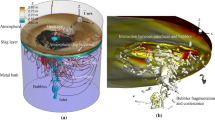Abstract
The investigation in the mixing characteristics of microscale shock cylindrical bubble interaction (SBI) provides a fundamental perspective into the microscale fuel injection. In present paper, the mixing performance of multi-scale SBI is numerically studied based on compressible Navier–Stokes equation. Starting from the bubble morphology, a scaling behavior of concentration distribution is exhibited in macroscale dynamics, whereas a superior capability of concentration decaying is observed in microscale cases. On the basis of mixedness evaluation, the mixing property of microscale bubbles is reinforced in the pre-interaction stage with notable viscous diffusion, and suppressed in the later evolution in the absence of vortex formation. Resorting to the Lagrangian coherent structure, a spatial coincidence between fluid stretching and mixing extent is visualized. The present study attempts to clarify the physical rationality of microscale injection strategies such as the atomization process and multiple micro-nozzles for mixing enhancement. Further efforts are devoted to physically modelling the competing mechanism of stirring effect (macroscale dynamics) and viscous diffusion (microscale dynamics) for optimal mixing performance.





Similar content being viewed by others

References
Meshkov E (1969) Instability of the interface of two gases accelerated by a shock wave. Fluid Dyn 4:101–104
Richtmyer R (1960) Taylor instability in shock acceleration of compressible fluids. Commun Pure Appl Math 13:297–319
Klein R, McKee C, Colella P (1994) On the hydrodynamic interaction of shock waves with interstellar clouds. 1: nonradiative shocks in small clouds. Astrophys J 420:213–236
Lindl J (1995) Development of the indirect drive approach to inertial confinement fusion and the target physics basis for ignition and gain. Phys Plasmas 2:3933–4024
Yang J, Kubota T, Zukoski E (1993) Applications of shock-induced mixing to supersonic combustion. AIAA J 31:854–862
Ranjan D, Oakley J, Bonazza R (2011) Shock-bubble interactions. Annu Rev Fluid Mech 43:117–140
Rudinger G, Somers L (1960) Behaviour of small regions of different gases carried in accelerated gas flows. J Fluid Mech 7:161–176
Luo X, Wang M, Si T (2015) On the interaction of a planar shock with an sf6 polygon. J Fluid Mech 773:366–394
Yang J, Kubota T, Zukoski E (1994) A model for characterization of a vortex pair formed by shock passage over a light-gas inhomogeneity. J Fluid Mech 258:217–244
Niederhaus J, Greenough J, Oakley J (2008) A computational parameter study for the three dimensional shock bubble interaction. J Fluid Mech 594:85–124
Ranjan D, Niederhaus JHJ, Oakley JG (2008) Shock-bubble interactions: features of divergent shock-refraction geometry observed in experiments and simulations. Phys Fluids 20:036101
Ding J, Si T, Chen M (2017) On the interaction of a planar shock with a three-dimensional light gas cylinder. J Fluid Mech 828:289–317
Sha S, Chen Z, Xue D (2013) The generation of jet and mixing induced by the interaction of shock wave with R22 cylinder. Acta Phys Sin 62:144701
Kumara S, Orlicz G, Tomkins C (2005) Stretching of material lines in shock-accelerated gaseous flows. Phys Fluids 17:082107
Jacobs JW (1992) Shock-induced mixing of a light-gas cylinder. J Fluid Mech 234:629–649
Tomkins C, Kumar S, Orlicz G (2008) An experimental investigation of mixing mechanisms in shock-accelerated flow. J Fluid Mech 611:131–150
Gallis M, Koehler T, Torczynski J (2015) Direct simulation Monte Carlo investigation of the Richtmyer–Meshkov instability. Phys Fluids 27:084105
Singh S, Karchani A, Myong RS (2018) Non-equilibrium effects of diatomic and polyatomic gases on the shock-vortex interaction based on the second-order constitutive model of the Boltzmann–Curtiss equation. Phys Fluids 30:016109
Ern A, Giovangigli V (1994) Multicomponent transport algorithms. Springer Science and Business Media, Berlin
Kee RJ, Coltrin ME, Glarborg P (2005) Chemically reacting flow: theory and practice. Wiley, Hoboken
Kee R, Rupley F, Meeks E, Miller J (1996) Chemkin-III a fortran chemical kinetics package for the analysis of gas-phase chemical and plasma kinetics, Sandia national laboratories report SAND96-8216
Wang Z, Yu B, Chen H et al (2018) Scaling vortex breakdown mechanism based on viscous effect in shock cylindrical bubble interaction. Phys Fluids 30:126103
Liu X, Osher S, Chan T (1994) Weighted essentially non-oscillatory schemes. J Comput Phys 115:200–212
Spiteri RJ, Ruuth SJ (2003) Non-linear evolution using optimal fourth-order strong-stability-preserving Runge–Kutta methods. Math Comput Simul 62:125–135
Verwer J, Sommeijer B (2004) RKC time-stepping for advection-diffusion-reaction problems. J Comput Phys 20:61–79
Bagabir A, Drikakis D (2001) Mach number effects on shock-bubble interaction. Shock Waves 11:209–218
Gupta S, Zhang S, Zabusky N (2003) Shock interaction with a heavy gas cylinder: emergence of vortex bilayers and vortex-accelerated baroclinic circulation generation. Laser Part Beams 21:443–448
Cetegen BM, Mohamad N (1993) Experiments on liquid mixing and reaction in a vortex. J Fluid Mech 249:391–414
Haller G (2015) Lagrangian coherent structures. Annu Rev Fluid Mech 47:137–162
Qin S, Liu H, Xiang Y (2018) Lagrangian flow visualization of multiple co-axial co-rotating vortex rings. J Vis 21:63–71
Acknowledgements
The authors would like to thank the Centre for High Performance Computing of SJTU for providing the supercomputer \(\pi \) to support this research. This work was financially supported by the National Natural Science Foundation of China (Grant Nos. 91741113, 91841303, and 91941301).
Author information
Authors and Affiliations
Corresponding author
Rights and permissions
About this article
Cite this article
Wang, Z., Yu, B., Zhang, B. et al. Behavior of mixing enhancement in microscale shock cylindrical bubble interaction. AS 4, 143–149 (2021). https://doi.org/10.1007/s42401-020-00076-5
Received:
Revised:
Accepted:
Published:
Issue Date:
DOI: https://doi.org/10.1007/s42401-020-00076-5



